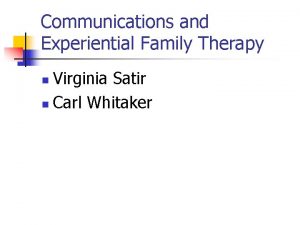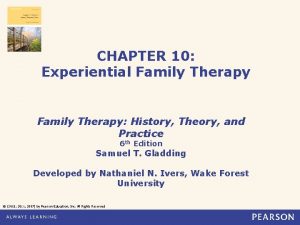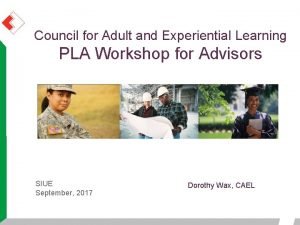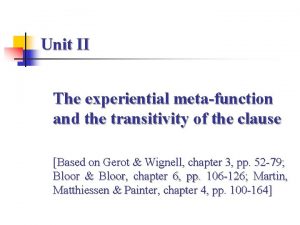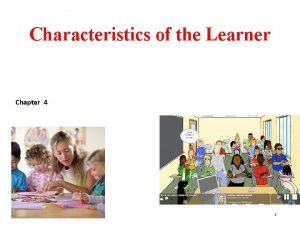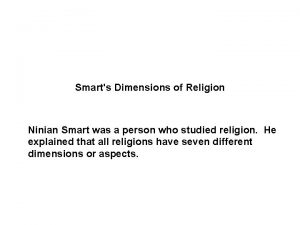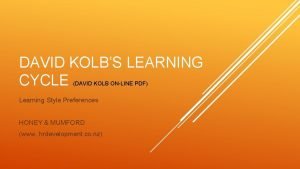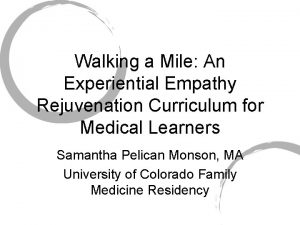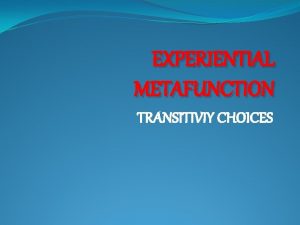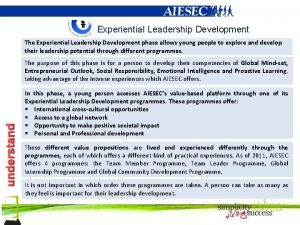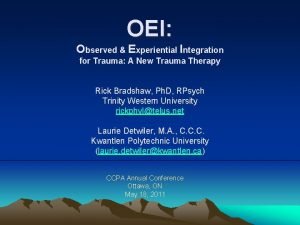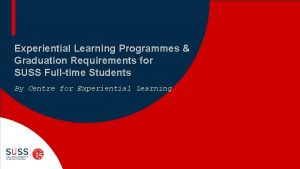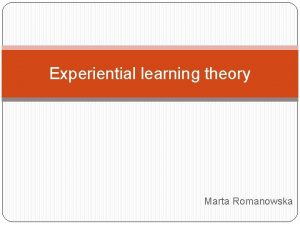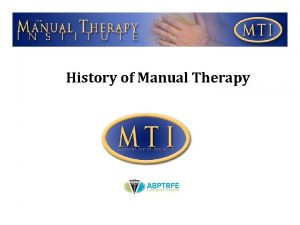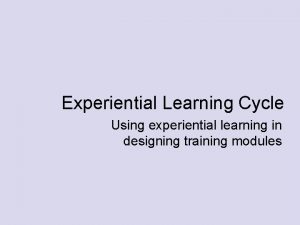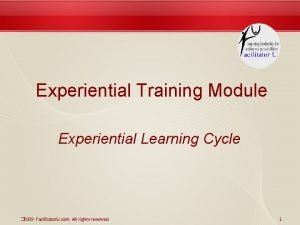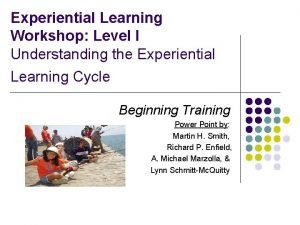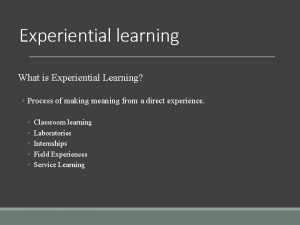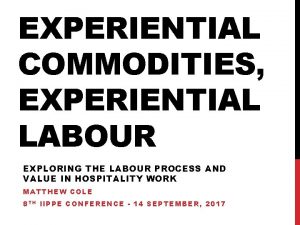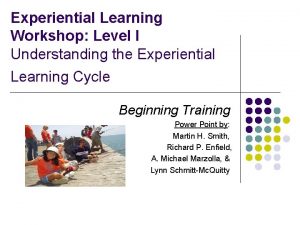CHAPTER 10 Experiential Family Therapy History Theory and
















- Slides: 16

CHAPTER 10: Experiential Family Therapy: History, Theory, and Practice 6 th Edition Samuel T. Gladding Developed by Nathaniel N. Ivers, Wake Forest University © (2015, 2011, 2007) by Pearson Education, Inc. All Rights Reserved

Overview • Importance of Affect in Experiential Family Therapy • Major Theorists • Premises • Techniques • Roles of the Therapist • Processes • Outcomes of Experiential Family Therapy • The Uniqueness of Experiential Family Therapy Gladding, Family Therapy: History, Theory, and Practice, 6 th Ed. © (2015, 2011, 2007) by Pearson Education, Inc. All Rights Reserved 10 -2

Experiential Family Therapy • Emerged out of the humanistic-existential psychology movement in the 1960 s • Influenced heavily by Gestalt therapy, psychodrama, client-centered therapy, and the encounter group movement • Emphasizes affect. • A healthy family is one in which people openly experience life with each other in a lively manner Gladding, Family Therapy: History, Theory, and Practice, 6 th Ed. © (2015, 2011, 2007) by Pearson Education, Inc. All Rights Reserved 10 -3

Major Theorists • David Kantor • Frank Duhl • Bunny Duhl • Virginia Satir • Carl Whitaker • Bernard Guerney • Walter Kempler • Augustus Napier • Leslie Greenberg • David Keith Gladding, Family Therapy: History, Theory, and Practice, 6 th Ed. © (2015, 2011, 2007) by Pearson Education, Inc. All Rights Reserved 10 -4

Virginia Satir • Published her first book, Conjoint Family Therapy, in 1964 • Described as a master of communication and originator of the family communications theory • Worked with more than 5, 000 families, often in group family therapy • Her model of counseling is referred to as the human validation process model Gladding, Family Therapy: History, Theory, and Practice, 6 th Ed. © (2015, 2011, 2007) by Pearson Education, Inc. All Rights Reserved 10 -5

Carl Whitaker • Innovative, spontaneous, and unstructured • Main contribution was that of helping families get in contact with their absurdity • Challenged people to examine their view of reality • Since 1988, his approach has been called experiential symbolic family therapy Gladding, Family Therapy: History, Theory, and Practice, 6 th Ed. © (2015, 2011, 2007) by Pearson Education, Inc. All Rights Reserved 10 -6

Premises of the Theory • Families are not aware of their emotions or, if aware, they suppress them • Lack of emotional awareness and express leads to emotional deadness • The resolution is to emphasize sensitivity and feeling expression among family members • Emotional expressivity can be verbal but it often is manifested affectively or behaviorally • Emphasis placed on the present • Humanistic and phenomenological in origin, and also influenced by attachment theory Gladding, Family Therapy: History, Theory, and Practice, 6 th Ed. © (2015, 2011, 2007) by Pearson Education, Inc. All Rights Reserved 10 -7

Treatment Techniques Therapists Who Use Few Techniques: Carl Whitaker: • • Redefine symptoms as efforts for growth • Model fantasy alternatives to real-life stress • Separate interpersonal stress and intrapersonal stress • Add practical bits of intervention • Augment the despair of a family member • Promote affective confrontation • Treat children like children and not like peers Gladding, Family Therapy: History, Theory, and Practice, 6 th Ed. © (2015, 2011, 2007) by Pearson Education, Inc. All Rights Reserved 10 -8

Treatment Techniques Therapists who use structured techniques: Virginia Satir • • Modeling of effective communication • Using “I” messages • Blamer • Placater • Distractor • Computer Gladding, Family Therapy: History, Theory, and Practice, 6 th Ed. © (2015, 2011, 2007) by Pearson Education, Inc. All Rights Reserved 10 -9

Structured Techniques Continued Sculpting • • Setting the scene • Choosing rule players • Creating a sculpture • Processing the sculpture • Choreography • Humor • Touch Gladding, Family Therapy: History, Theory, and Practice, 6 th Ed. © (2015, 2011, 2007) by Pearson Education, Inc. All Rights Reserved 10 -10

Structured Techniques Continued • Props • Family Reconstruction • • Star or explorer and Guide Tools for family reconstruction • Family map • Family life fact chronology • Wheel or circle of influence Gladding, Family Therapy: History, Theory, and Practice, 6 th Ed. © (2015, 2011, 2007) by Pearson Education, Inc. All Rights Reserved 10 -11

Other Experiential Techniques • Play Therapy • Filial Therapy • Family Drawings • • Conjoint family drawing • Symbolic drawing of family life space Puppet Interviews Gladding, Family Therapy: History, Theory, and Practice, 6 th Ed. © (2015, 2011, 2007) by Pearson Education, Inc. All Rights Reserved 10 -12

Role of the Therapist • Participate actively (less structured) • Facilitate or provide resources (structured) • Assist family members to discover their individuality and fid fulfilling rules for themselves • Establish an environment that communicates warmth, acceptance, respect, and hope • Help family members to clarify goals and to use their natural abilities • Likely to behave as real, authentic people Gladding, Family Therapy: History, Theory, and Practice, 6 th Ed. © (2015, 2011, 2007) by Pearson Education, Inc. All Rights Reserved 10 -13

Process and Outcome • Family members gain awareness of their needs and feelings and share them with others • Families members become more capable of autonomy and real intimacy through awareness of feelings • Helps family members fulfill roles for themselves without an overriding concern for the needs of the family as a whole Gladding, Family Therapy: History, Theory, and Practice, 6 th Ed. © (2015, 2011, 2007) by Pearson Education, Inc. All Rights Reserved 10 -14

Process and Outcome The process differs for each experiential family therapist • • Whitaker • Engagement • Involvement • Satir • Making contact • Chaos • Integration Gladding, Family Therapy: History, Theory, and Practice, 6 th Ed. © (2015, 2011, 2007) by Pearson Education, Inc. All Rights Reserved 10 -15

Unique Aspects of Experiential Family Therapy • Training Programs • Research • Length of treatment • Attention to emphasizing people as well as structures within the change process Gladding, Family Therapy: History, Theory, and Practice, 6 th Ed. © (2015, 2011, 2007) by Pearson Education, Inc. All Rights Reserved 10 -16
 Satir experiential family therapy
Satir experiential family therapy Conjoint family drawing
Conjoint family drawing Council for adult and experiential learning
Council for adult and experiential learning Psychoanalytic therapy is to as humanistic therapy is to
Psychoanalytic therapy is to as humanistic therapy is to Bioness bits cost
Bioness bits cost Psychoanalytic therapy is to as humanistic therapy is to
Psychoanalytic therapy is to as humanistic therapy is to Experiential function
Experiential function Ruth anne rehfeldt
Ruth anne rehfeldt What are the three determinants of learning
What are the three determinants of learning Ninian smarts model
Ninian smarts model Kolb learning cycle pdf
Kolb learning cycle pdf Experiential empathy
Experiential empathy Numerative
Numerative Experiential leadership development
Experiential leadership development Oei therapy
Oei therapy Suss portfolium
Suss portfolium Experiential learning portfolio
Experiential learning portfolio
